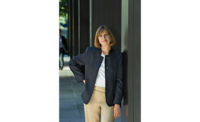The Getty wrangles a herd of exhibitions on postwar architecture and design.
| Photo © Ed Ruscha/J. Paul Getty Museum |
In a keynote address at the University of Southern California in 1940, Frank Lloyd Wright dismissed the built environment of Los Angeles as amounting to little more than a “dish of tripe.” But even without the notable houses he'd built there himself, the city's unfolding architectural saga was already more complex and, in some respects, more appealing than a dollop of offal. And over the next half-century, L.A.'s rapid evolution would produce enough fare–both loathsome and savory–to merit Pacific Standard Time Presents: Modern Architecture in L.A., a Getty-sponsored collaboration with exhibitions and events at 17 venues across the region this spring and summer.
In 2011 and 2012, Pacific Standard Time: Art in L.A. 1945-1980 engaged 60 cultural institutions to explore the emergence of the city's art scene in the decades after World War II (record, November 2011, page 36). Naturally, design played a role. But in the second act, architecture is now the focus. With it comes the perpetual conundrum of how to create vital and meaningful exhibitions about buildings, urban conditions, and works far too large or impractical to display in galleries. The responses to this familiar dilemma are as varied as the shows, their subject matter, and their venues.
Like PST, with its panoramic though spotty overview of art, PSTP is (by design) a loose potpourri of exhibitions and events. Without imposing a unifying approach, the Getty has embraced cultural institutions of vastly different scales, missions, personalities, and holdings–for installations ranging from single-architect retrospectives (featuring, for example, A. Quincy Jones at UCLA's Hammer Museum) to grand surveys, such as Overdrive: L.A. Constructs the Future, 1940-1990, at the Getty Center and A New Sculpturalism: Contemporary Architecture from Southern California at the Museum of Contemporary Art, a show that faces possible cancellation. The mix also includes an exhibition of Ed Ruscha's depictions of Standard gas stations (at the Getty) and others that are themed or entirely unconventional. For example, in As He Remembered It, at the Los Angeles County Museum of Art (LACMA), artist Stephen Prina re-creates, in hot pink, the built-ins from two now-demolished R.M. Schindler houses. Quirky and conceptual, this spatial disconnect questions the site-specificity of Los Angeles Modernism.
But Overdrive, implicitly the framework for all the other shows, is perhaps not unconventional enough. With 400-plus objects compartmentalized into a series of didactic categories, it's like reading an essay where you can practically see the stiff, underlying outline, with its Roman numerals, letters, and enumerated lists. The labeled categories–“Car Culture”; “Urban Networks” (dealing with infrastructure); “Engines of Innovation” (local “industries” like oil, aerospace, higher education, and entertainment); “Community Magnets” (a catch-all for museums, sports stadiums, religious centers, and Disneyland); and “Residential Fabric”–are far-reaching but encapsulate almost every cliché about this sprawling city. And the time frame of 1940 to 1990 seems questionable, if not arbitrary; Southern California's brand of architectural Modernism emerged decades earlier, in the work of Irving Gill, Schindler, Richard Neutra, and others, and had run its course long before 1990.
Even with these significant shortcomings, the show's strength lies in its broad sweep and individual treasures. The Getty's outstanding holdings–including the archives of architectural photographer Julius Shulman and architects John Lautner, Ray Kappe, and Pierre Koenig–are well represented, as are many less expected sources, like transportation-agency holdings. So it's worth looking past the exhibition's tedious and often unimaginative nature to such engrossing objects as Lautner's expressive pencil drawings or Will Connell's artful photos.
And if notions of Modernism seem chronologically compromised here, the interpretations become far looser across PSTP, with shows as divergent as A Confederacy of Heretics at SCI-Arc (which revisits an influential series of renegade architectural events of 1979; see review at archrecord.com/news) and The Presence of the Past: Peter Zumthor Reconsiders LACMA. The latter lets LACMA examine its own buildings, making a case for Swiss architect Zumthor's scheme for a radical transformation. At Cal Poly Pomona, Technology and Environment: The Postwar House in Southern California revisits Mid—Century Modern classics with 21st-century sustainability analysis.
One intriguing-sounding show (not yet open when this article went to press) is the MAK Center's Everything Loose Will Land. Exploring cross-pollination between architecture and art, it takes its title from another of Wright's barbs about the city: “Tip the world over on its side and everything loose will land in Los Angeles.” A lot has landed in PSTP–and, despite some bits of tripe, there's much worth savoring.









Post a comment to this article
Report Abusive Comment